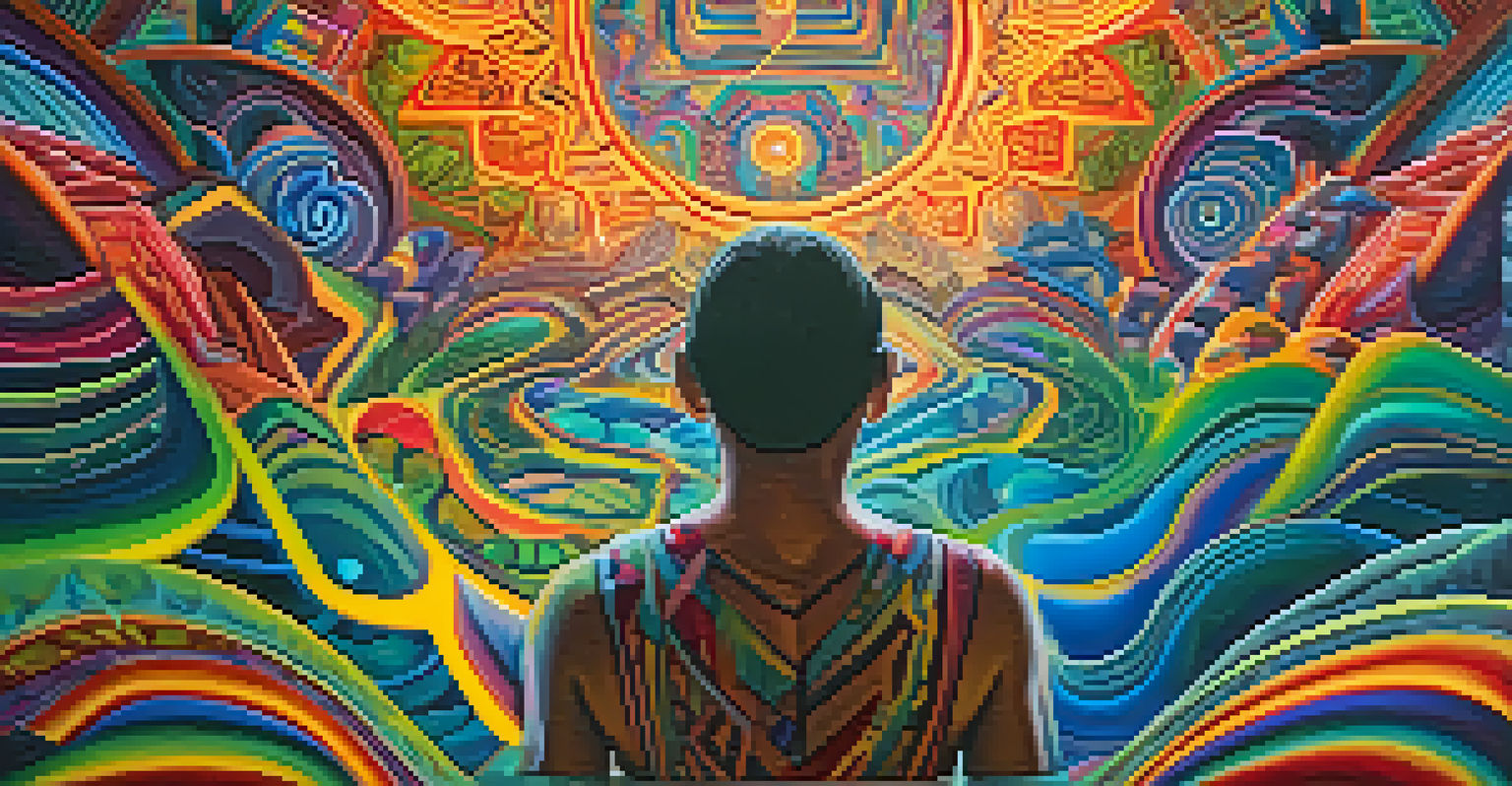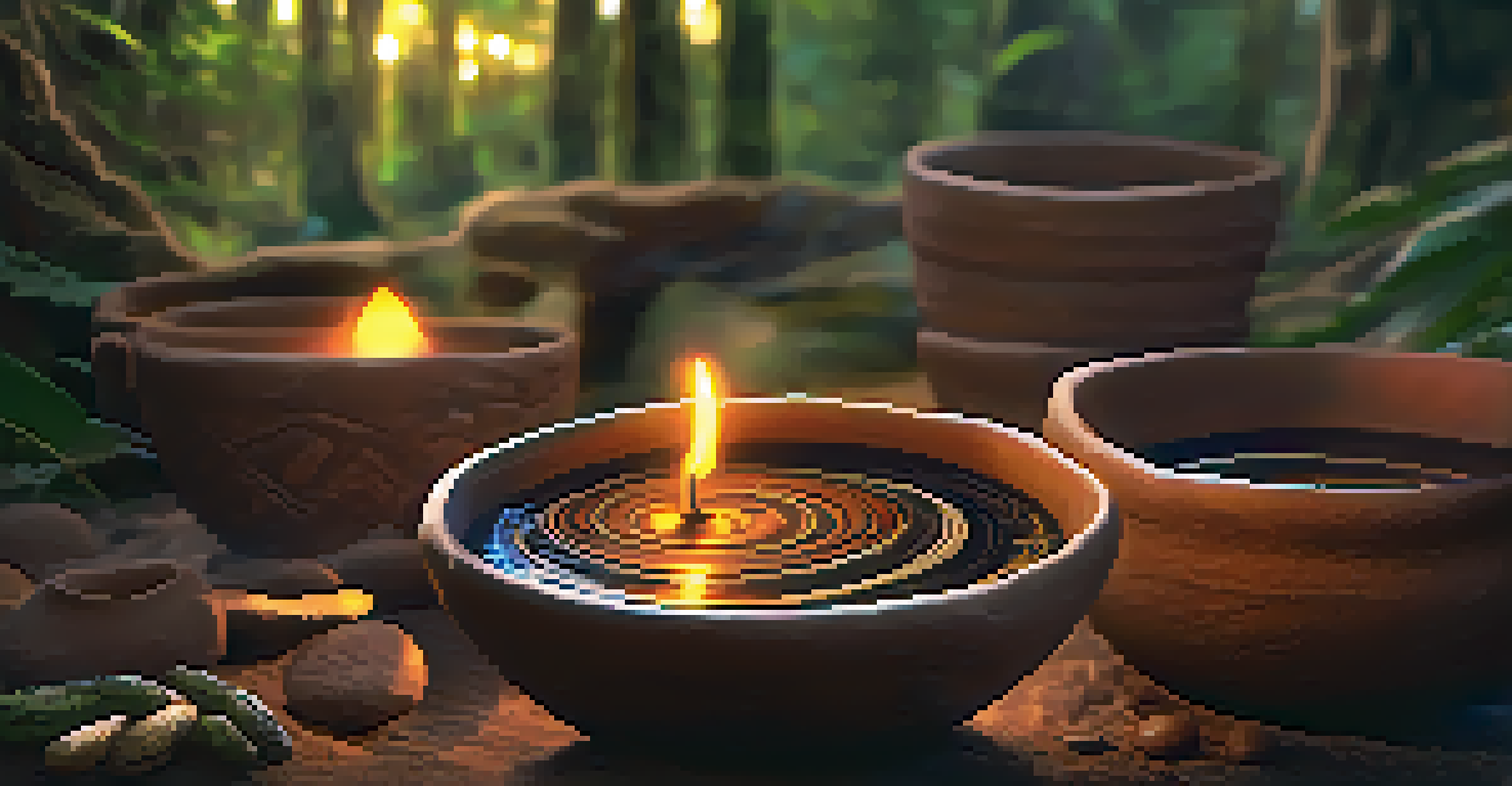Ayahuasca and the Exploration of Subconscious Mind Layers

What is Ayahuasca and Its Cultural Significance?
Ayahuasca is a powerful brew made from the Banisteriopsis caapi vine and the Psychotria viridis leaf. Traditionally used by indigenous Amazonian tribes, this entheogenic drink has been a cornerstone of spiritual and healing practices for centuries. Its ability to induce altered states of consciousness has made it a focal point for those seeking deeper understanding of themselves and the cosmos.
The greatest discovery of my generation is that a human being can alter his life by altering his attitude.
The cultural significance of Ayahuasca extends beyond mere consumption; it is often part of elaborate ceremonies led by experienced shamans. These rituals emphasize community, connection, and respect for nature. Participants not only seek personal healing but also a reconnection with their roots and the natural world around them.
In recent years, Ayahuasca has gained attention globally, attracting those interested in personal growth, mental health, and even artistic inspiration. As more people turn to these ancient practices, the blend of tradition and modern exploration continues to evolve.
The Science Behind Ayahuasca and Its Effects
The primary psychoactive component of Ayahuasca is DMT (dimethyltryptamine), which is a naturally occurring substance found in various plants and even in the human brain. When consumed, DMT can lead to intense visual and emotional experiences, often described as journeying into the depths of one’s subconscious. This unique interaction allows users to confront fears, traumas, and suppressed emotions.

Research suggests that Ayahuasca may facilitate neurogenesis, the formation of new neurons, particularly in the hippocampus, an area of the brain associated with memory and emotional regulation. This could explain why many individuals report lasting positive changes in mood and mental clarity after an Ayahuasca experience.
Cultural Roots of Ayahuasca Use
Ayahuasca is deeply embedded in the spiritual and healing traditions of indigenous Amazonian tribes, emphasizing community and connection with nature.
Moreover, the combination of DMT with other compounds in the brew can create a synergistic effect, enhancing emotional introspection. Participants often describe feeling a profound sense of interconnectedness, not just with themselves but with the universe, which can lead to significant personal insights.
Navigating the Layers of the Subconscious Mind
The subconscious mind is often likened to an iceberg, where only a small part is visible above the surface. Ayahuasca acts as a diving tool, allowing individuals to explore the deeper layers hidden beneath their conscious thoughts. This exploration can reveal unresolved issues, childhood memories, and patterns that influence present behavior.
The mind is everything. What you think you become.
As participants journey through different layers, they may encounter emotions that have long been buried. This process can be both challenging and cathartic, as confronting these feelings often leads to understanding and healing. For many, it's like peeling back the layers of an onion, where each layer reveals more about one’s true self.
Ultimately, this journey into the subconscious can foster personal growth and transformation. By shining a light on these hidden aspects, individuals can emerge with a clearer sense of identity and purpose, ready to face the world with renewed strength.
Common Experiences During Ayahuasca Ceremonies
Participants in Ayahuasca ceremonies often report a wide range of experiences, from vivid visualizations to deep emotional releases. Some may see colorful patterns or even encounter symbolic figures, which can carry personal significance. These experiences are often deeply personal, providing insights tailored to each individual's journey.
An important aspect of these ceremonies is the purging process, which can manifest as vomiting or intense emotional release. While this may sound daunting, many view it as a necessary step towards cleansing both physically and emotionally. It symbolizes the release of negativity and the making space for healing.
Emotional Depth and Healing
The brew's psychoactive properties, primarily from DMT, facilitate profound emotional introspection and can lead to lasting positive changes in mood and mental clarity.
Moreover, participants frequently describe feelings of unity and connection with others present in the ceremony. This communal aspect not only enhances the experience but also helps to reduce feelings of isolation, making the journey feel more supportive and shared.
Integrating Insights Post-Ayahuasca Experience
After an Ayahuasca journey, the integration process is crucial. This is the time when individuals reflect on their experiences and insights, seeking to incorporate them into their daily lives. Journaling, therapy, and discussions with fellow participants can aid in this process, helping to solidify the lessons learned.
Integration may involve making lifestyle changes, such as adopting healthier habits or letting go of toxic relationships. These transformations are often inspired by the clarity gained during the ceremony, as participants feel more aligned with their true selves. It’s like waking up from a dream and deciding to live the life you’ve always wanted.
Additionally, the integration process can reveal ongoing challenges. It's important to approach these changes with patience and self-compassion, recognizing that growth is a journey, not a destination. Support systems, whether through community or professional help, can be invaluable during this time.
Potential Risks and Considerations of Ayahuasca
While Ayahuasca can offer profound insights and healing, it is essential to approach it with caution. The brew can provoke intense emotional responses, and not everyone is prepared for the depth of experience it may bring. Individuals with a history of mental health issues, particularly psychosis, are often advised to avoid it.
Moreover, the setting in which Ayahuasca is consumed plays a significant role in the overall experience. Ceremonies should ideally be conducted in safe, supportive environments led by experienced facilitators. This ensures participants can navigate the often turbulent waters of their subconscious with guidance.
Importance of Integration After Use
Post-Ayahuasca, individuals must integrate their insights into daily life, often through journaling and support systems, to foster personal growth and transformation.
Lastly, it’s important to consider the legality of Ayahuasca in different countries. While some places embrace its use, others may have strict regulations. Always research and respect local laws and customs to ensure a safe and meaningful journey.
The Future of Ayahuasca in Modern Society
As interest in alternative healing practices grows, Ayahuasca is likely to continue gaining popularity around the world. This rise brings both opportunities and challenges, as the balance between traditional practices and modern adaptations becomes increasingly important. Preserving the cultural heritage while ensuring ethical use is crucial.
Moreover, the ongoing research into Ayahuasca’s therapeutic effects may pave the way for its integration into mainstream mental health treatments. As studies highlight its potential in treating conditions like depression and PTSD, more mental health professionals may consider it a viable option.

However, with this growing interest comes the responsibility to educate participants thoroughly. Ensuring that individuals understand what to expect, the potential risks, and the importance of integration is vital for fostering safe and meaningful experiences.